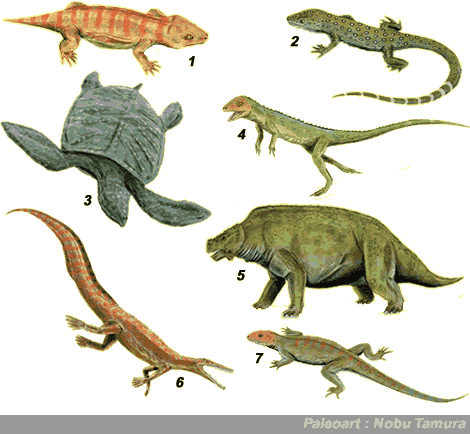
The stem-procolophonian Nyctiphruretus acudens, Middle Permian (Roadian/Wordian) of Russia
Artwork by Dmitry Bogdanov, via Wikipedia, GNU Free Documentation/Creative Commons Attribution Share Alike
| Anapsida | ||
| The Vertebrates | Overview |
| Vertebrates Home | Vertebrate | Vertebrate |
|
Abreviated Dendrogram
Reptiliomorpha
├─Synapsida
└─┬─Eureptilia
│
└─Anapsida
├─┬─Millerettidae
│ └─Eunotosaurus
├─Mesosauridae
└─┬─Lanthanosuchoidea
└─┬─Bolosauridae
└─Procolophonia
├─┬─Nycteroleteridae
│ └─Pareiasauridae
└─Procolophonoidea
├─Owenettidae
│ └?─Testudines
└─Procolophonidae
|
Contents
Overview |
 The stem-procolophonian Nyctiphruretus acudens, Middle Permian (Roadian/Wordian) of Russia Artwork by Dmitry Bogdanov, via Wikipedia, GNU Free Documentation/Creative Commons Attribution Share Alike |
 The term Anapsida ("no arch") originally referred to all those reptile groups that lack skull openings behind the eyes. Originally most of the primitive ancestral reptiles were included here, as well as the turtles. It is now known that this is a rather artificial group. The lizard-like Permo-Carboniferous captorhinids - originally placed here (see no.7 in the illustration at the right), have bene shown to represent a seperate group. There is also some controversy about whether the Turtles, for a long time included among the anapsids, belong here (in these dendragrams we have gone with the rather unimaginative option that turtles evolved from procolophonian anapsids);. That still leaves a diverse selection of Permo-Triassic reptiles, from small insectivorous species superficially similar to living lizards to great cumbersome armoured herbivores (such as the Scutosaurus no.5 at the right). The alternative term "Parareptilia" ("alongside reptiles") is sometimes used to describe eitehr the group as a whole (Tsuji & Müller 2009) or the majority subgroup (Modesto & Anderson 2004). This would be fine if the premise was that this was a totally extinct group, but this term is often used even when including turtles. Because this is as confusing (even if technically correct) as calling crocodiles pseudosuchia ("false crocodiles") (Gauthier 1986), we have chosen to retain the more traditional name.
The term Anapsida ("no arch") originally referred to all those reptile groups that lack skull openings behind the eyes. Originally most of the primitive ancestral reptiles were included here, as well as the turtles. It is now known that this is a rather artificial group. The lizard-like Permo-Carboniferous captorhinids - originally placed here (see no.7 in the illustration at the right), have bene shown to represent a seperate group. There is also some controversy about whether the Turtles, for a long time included among the anapsids, belong here (in these dendragrams we have gone with the rather unimaginative option that turtles evolved from procolophonian anapsids);. That still leaves a diverse selection of Permo-Triassic reptiles, from small insectivorous species superficially similar to living lizards to great cumbersome armoured herbivores (such as the Scutosaurus no.5 at the right). The alternative term "Parareptilia" ("alongside reptiles") is sometimes used to describe eitehr the group as a whole (Tsuji & Müller 2009) or the majority subgroup (Modesto & Anderson 2004). This would be fine if the premise was that this was a totally extinct group, but this term is often used even when including turtles. Because this is as confusing (even if technically correct) as calling crocodiles pseudosuchia ("false crocodiles") (Gauthier 1986), we have chosen to retain the more traditional name.
In terms of their known evolutionary history, the Anapsids appeared suddenly during the later part of the early Permian; in the evolutionary stratigraphic paradigm they evolving from captorhinomorphs (Carroll 1988), whereas in the cladistic paradigm both anapsids and captorhinids evolved from an unknown common ancestor (Laurin and Reisz 1995). Regardless of their origin, anapsids diversified quickly, supplanting the captorhinids as a lizard-like ecomorph.
During the Middle Permian, some anapsids evolved into huge, heavily armored herbivores, the pareiasaurs like the afore-mentioned Scutosaurus. These early ankylosaur or glyptodont analogues often had widely-flared skulls, ornamented with irregular blobs of bone, looking like half-melted wax. The overall appearance is so bizarre that MSY Lee has aptly named the pareiasaur - lanthanosuchid taxon the Hallucicrania. Lee (1997) has argued forcefully that turtles evolved from a dwarf lineage of pareiasaurs. Apart from the question of turtle relationships, it seems only a single lineage of anapsids the procolophonids - survived into the Triassic. There they flourished and diversified, before dying out at the end of the period to be replaced by lepidosaurian sphenodonts (Rhynchocephalia).
(ATW & MAK, revised MAK120401)
Image: A selection of anapsids and reptiles that have previously been considered anapsids. (1) 1) Procolophon, a specialised herbivorous anapsid that ranged widely across Gondwana during the early Triassic; (2) Millereta, A small Late Permian anapsid from South Africa superficially very similar to extant lizards; (3) Archelon a gigantic Cretaceous protostegid turtle from the Western inland sea (the anapsid affinities of turtles (4) Eudibamus, an Early Permian bolosaur from Western Europe, a facilatively bipedal lizard-like form; (5) Scutosaurus, a giant armored herbivore of the late Permian of Eastern Europe (Laurasia); (6) Mesosaurus a highly specialised aquatic reptile from the early Permain of Gondwana, (7) Hylonomus a middle Carboniferous captorhinomorph eureptile (not an anapsid, but previously classified as one).
Artwork by Nobu Tamura, Creative Commons Attribution Share Alike, via Reptiles org; MAK120401
checked ATW040118, revised MAK120322